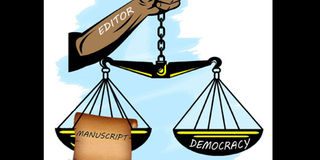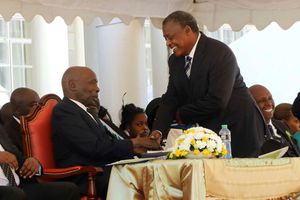Premium
How the books that editors rejected are now haunting us

There is little doubt that we, publishing editors, carry our personal intellectual and artistic baggage to work. We bring to the manuscripts that we assess our personal handicaps, our blinkers and allied skewed cargo. ILLUSTRATION| JOHN NYAGAH
What you need to know:
One of the authors present buoyantly gamboled to the front to be crowned. He threw in some histrionics for good measure.
Staff from the winning house rent the air with sounds of deafening merriment — including from those who obviously knew nothing about the books. But it was their moment of glory.
There is little doubt that we, publishing editors, carry our personal intellectual and artistic baggage to work. We bring to the manuscripts that we assess our personal handicaps, our blinkers and allied skewed cargo.
I have often gritted my teeth at literary awards functions. You listen in disbelief as titles that you turned down are read out for award.
Sometimes you think it is a different book until you discover that a more judicious publisher issued the script under a different title.
In 2005, I stood by and watched hopelessly. Kyalo Wamitila’s Musaleo and Ken Walibora’s Kufa Kuzikana won the Jomo Kenyatta Prize for Literature in the Kiswahili category.
My colleagues and I threw knowing glances at each other. Our thoughts flew crisply and found a meeting point. We were beholden in silent rue about lost opportunities and failed glory.
One of the authors present buoyantly gamboled to the front to be crowned. He threw in some histrionics for good measure.
Staff from the winning house rent the air with sounds of deafening merriment — including from those who obviously knew nothing about the books. But it was their moment of glory.
I had had the chance to interact with the two gems in manuscript. I thought that they would make for good literature. But the nature of making editorial decisions can sometimes be daunting.
After the arguments for or against a script have been exhausted around the table, the chair will sometimes take a vote.
The motion is simple, accept or reject? In turns, people will say, “Accept.” Others will say, “Reject.” This includes both those who have read the script and those who have not.
Those who haven’t read will have benefitted from editorial reports, both from within the house and outside. Others only listen to what is said around the table and decide. Eventually, democracy carries the day.
In my long and rich life, I have learnt that democracy is not such a great thing. It is not half as good as we are made to believe. It is certainly not the best way to judge art and creativity.
It is horrible. Indeed, it is hardly the best way to make any useful decision, anywhere. We have heard it said nonetheless that democracy allows the majority to have things their way while the minority have
their say.
HARDLY EVER RIGHT
The tragedy is that the majority are hardly ever right on anything. If you ask Christians, they will tell you that the majority voted for the crucifixion of Jesus Christ.
Historians will tell you that Christopher Columbus (1451 – 1506) was in the minority when he said, “I think the earth is round.” And before him, other minorities stood in solitary corners with their lonely truths.
When Nicolaus Copernicus (1473 – 1543) suggested that the sun was at the centre of the universe, his ideas were ridiculed, despite his great learning in the arts and sciences alike.
When Galileo Galilei (1564 – 1642) later expanded and defended the ideas of Copernicus, the Catholic world took this as a personal attack against Pope Urban VIII. Galileo was tried by the dreaded grand
inquisition.
He was found “vehemently suspect of heresy.” He was placed under house arrest for the rest of his life.
Does the editorial board sometimes take on the character of the grand inquisition, listening to the case against manuscripts? I have had the misfortune of hearing an editor vote against a manuscript because, he
says: “The story does not grip me.”
They say in Kiswahili, ushikwapo shikamana. This is to say when they try to get a grip of you, allow yourself to be gripped. So what should the manuscript do if the editor will not accept to be gripped?
If the editor lacks the intellectual depth and breadth to appreciate a good story, the story has little chance before the grand inquisition.
Mercifully, my editorial mentors often allowed editors to place their reputation on the line regarding manuscripts they felt very strongly about. Henry Chakava remains, in my mind, the foremost African
publisher.
As our team leader, he would maintain a patient and avuncular professorial mien, listening to each of us attentively. After everyone had rejected your sponsorship of some manuscript, he might say to you,
“Barrack, you seem to have such strong feelings about this script. I would allow you to place your reputation on it, if you are that confident about it.”
But reputation is not limited to the editors. Quite often, a canonical writer will walk in with a script that they consider ready-made. At East African Educational Publishers (and in its former incarnation as
Heinemann), we often pointed out perceived deficiencies in manuscripts from such writers as the late Prof Ali Mazrui, Taban Lo Liyong, Meja Mwangi and Ngugi wa Thiong’o.
In all cases, we offered to publish nonetheless, at the risk and peril of their reputation. Without exception, they each went back to their study rooms to rework the scripts.
The experience is quite different, however, with more youthful writers. They are less patient. Some are even suspicious. They think you will steal their manuscript. Others think you want a bribe.
An author once sent her mother to me with a succulent sheaf of crisp bank notes. They thought the notes could do what the manuscript could not do on its own.
I sent away the lady with her baggage. Several months later, they resubmitted the script, having attended to the editorial concerns. We published.
Sending away some writers can, however, be very daunting. Once my secretary buzzed me to say that Prof Joseph Maina Mungai was waiting to see me.
As I had thought, it turned out that the visitor was my former vice-chancellor at the University of Nairobi. He carried a simple rucksack, from which a bulky script presently materialised. It turned out that it was his biography.
He had, however, rendered it in third person narrative, appearing to be talking of some herdsboy who became a professor.
GRAVITY OF MEDICAL JARGON
Nowhere had the professor of human anatomy indicated that he was this character. Then there was the sheer gravity of medical jargon and other scientific detail. He would have to attend to these concerns.
“Very well, Barrack, it will be done,” he said as he walked away two months later, armed with editorial reports. He had listened to me in studious silence. He had asked a question or two, which I attempted to answer.
It is not very interesting when you are turning away your former vice-chancellor. Indeed you wonder whether you have done the right thing. But Prof Mungai humbled me. He personally brought back the
script after three months.
We published it to great acclaim by reviewers.
But we are not always right, as already observed. We make mistakes, sometimes very costly mistakes, too. In his debut years, virtually every publisher he wrote to rejected Chinua Achebe’s Things Fall Apart.
Today if you have not read Things Fall Apart, you must be envied. For the editor who sponsored it at Heinemann in 1956 wrote only a one sentence editorial report, “This is the best script I have read since
the end of the war (World War II).”
D. H. Lawrence’s Lady Chatterley’s Lover was turned down everywhere in the UK and in the United States. The author eventually published it himself in 1928, only for it to be banned because it was thought to be morally corrupting.
It is today a global bestseller. Alex Haley’s Roots was rejected about 200 times. Today it is not only a world-class leader; a powerful movie has been made out of it. Pearl Buck’s moving story of O-Lan and Wang Lung, The Good Earth, met the same fate.
One publishing editor told Buck that Americans were not interested in reading about China and the Chinese.
There have been scores of other great writers whom we publishers rejected, only for them to embarrass us. They are the proverbial capstones that the builders rejected. George Orwell, Albert Camus, Thomas Hardy, William Golding, Graham Green, Louisa
May Alcott, F. Scott Fitzgerald, Hermann Melville, James Joyce, Agatha Christie — all these are great names that we publishers turned down to our huge embarrassment.
One of the numerous rejections of Dan Brown’s The Da Vinci Code said: “It is so badly written.” The book has sold close to 90 million copies since. And when Vladimir Nabokov wrote Lolita, the publishing editor’s report read in part: “I recommend that it
should be buried under a stone for a thousand years.”
All those who had rejected it have since published it. Sales stand at close to 60 million copies.
Kenneth Grahame’s Wind in the Willows is a canonical point of reference for good writing, the world over. A publisher’s report dismissed the manuscript with the words: “This is an irresponsible holiday story.
It will never sell.” Sales run into dozens of millions.
Getting published can be a very chancy affair. Authors do well not to give up just because I turned them down. Often it is not what we are assessing that is faulty. It is sometimes the assessor and the
instruments that s/he is using to make the assessment.
It is a complex affair, however, for we don’t know everything, and neither do the writers.




